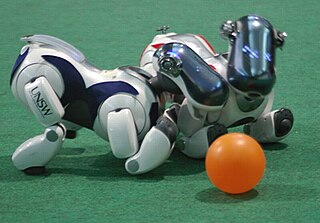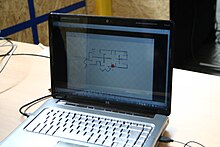RoboCup Junior (RCJ), sometimes stylised RobocupJunior, is a division of RoboCup, a not-for-profit robotics organisation. It focuses on education and aims to introduce the larger goals of the RoboCup project to primary and secondary school aged children. Participants compete in one of three main leagues: Soccer, Rescue or Dance. Dance Theatre also exists as a sub-league of Dance, and Premier Rescue is part of the competition in Australia.

The International Aerial Robotics Competition (IARC) began in 1991 on the campus of the Georgia Institute of Technology and is the longest running university-based robotics competition in the world. Since 1991, collegiate teams with the backing of industry and government have fielded autonomous flying robots in an attempt to perform missions requiring robotic behaviors never before exhibited by a flying machine. In 1990, the term “aerial robotics” was coined by competition creator Robert Michelson to describe a new class of small highly intelligent flying machines. The successive years of competition saw these aerial robots grow in their capabilities from vehicles that could at first barely maintain themselves in the air, to the most recent automatons which are self-stable, self-navigating, and able to interact with their environment—especially objects on the ground.
A robotic competition is an event where robots have to accomplish a task. Usually they have to beat other robots in order to become the best one. Many competitions are for schools but several professional competitions are arising.
The Federation of International Robot-soccer Association [sic] or FIRA for short is an international organisation organising competitive soccer - usually 5-a-side - competitions between autonomous robots.

As one of the founding leagues of the international RoboCup initiative, the RoboCup Middle Size League (MSL) robot soccer competition has been organised from 1997 onwards. On an indoor soccer field, with goals of reduced size, teams of five fully autonomous soccer playing robots compete against one another. No human intervention is allowed during a match, except to take robots on or from the field. Although limitations with respect to maximum size and weight are in place, teams are completely free to design both hardware and software.
Robotix is an annual robotics and programming event that is organised by the Technology Robotix Society at the Indian Institute of Technology Kharagpur. It is held during Kshitij, the institute's annual techno-management festival. Participation is open to college students. The event gives contestants an opportunity to showcase their talents in the fields of mechanical robotics, autonomous robotics and programming.

Microsoft Robotics Developer Studio is a Windows-based environment for robot control and simulation. It is aimed at academic, hobbyist, and commercial developers and handles a wide variety of robot hardware. It requires the Microsoft Windows 7 operating system.
A rescue robot is a robot that has been designed for the purpose of rescuing people. Common situations that employ rescue robots are mining accidents, urban disasters, hostage situations, and explosions. The benefits of rescue robots to these operations include reduced personnel requirements, reduced fatigue, and access to otherwise unreachable areas.
There are a number of competitions and prizes to promote research in artificial intelligence.
Iranian teams have been an active participant of RoboCup events since 1998. The number of Iranian teams has been largely increasing over the past years. Thereby, the need to have a regional event seemed rather necessary. Furthermore, since the overall number world interested teams in RoboCup has increased; regional events may and can be a proper field for RoboCup leagues Technical Committees to see teams qualities for RoboCup World Competitions. IranOpen is a place for teams willing to take part in RoboCup World Competitions in order to show their qualities and standards. It is also a place for fresh teams to gain experience and become ready to join the world teams.
Almost Human: Making Robots Think is a book written by Lee Gutkind founder of Creative Nonfiction. Gutkind spent six years as a "fly on the wall" researcher at the Robotics Institute at Carnegie-Mellon University in Pittsburgh. He observed scientists and students working to design, build, and test robots so advanced that they will one day be able to work alongside or, in some cases, even replace humans. Almost Human is an intense portrait of the robotic subculture and the challenging quest for robot autonomy. Almost Human is 330 pages long and is published by W.W. Norton. In May 2007 Gutkind appeared as a guest author on The Daily Show with Jon Stewart to talk about robots, the future, and his book.

The RoboCup Standard Platform League (SPL) is one of several leagues within RoboCup, an international competition with autonomous robotic soccer matches as the main event.

The RoboCup 2D Simulated Soccer League is the oldest of the RoboCup Soccer Simulation Leagues. It consists of a number of competitions with computer simulated soccer matches as the main event.

The RoboCup 3D Simulated Soccer League allows software agents to control humanoid robots to compete against one another in a realistic simulation of the rules and physics of a game of soccer. The platform strives to reproduce the software programming challenges faced when building real physical robots for this purpose. In doing so, it helps research towards the RoboCup Federation's goal of developing a team of fully autonomous humanoid robots that can win against the human world soccer champion team in 2050.
Claude Sammut is a Professor of Computer Science and Engineering at the University of New South Wales and Head of the Artificial Intelligence Research Group. He was the UNSW node Director of the ARC Centre of Excellence for Autonomous Systems (CAS) and a member of the joint ARC/NH&MRC project on Thinking Systems.

Student Robotics is a volunteer based organisation that runs an annual free-to-enter robotics competition for 16- to 18-year-olds.
Storming Robots is Robotics and Technology Learning Lab based in Branchburg, New Jersey. All of Storming Robots' programs are modeled to build and strengthen problem solving, computational and algorithmic thinking skills, and reinforce the engineering process. They use robotics as means to inspire children's interest and further their intellect in Science, Technology, Engineering, and Mathematics (STEM) and also analytic, computational, and strategic thinking.

Taurob tracker is a mobile robot, manufactured by taurob GmbH in Austria. It has been originally developed as a remote controlled reconnaissance platform for fire departments. but is currently used also by the military, civil-defense units, universities and the oil and gas industry around the world.









